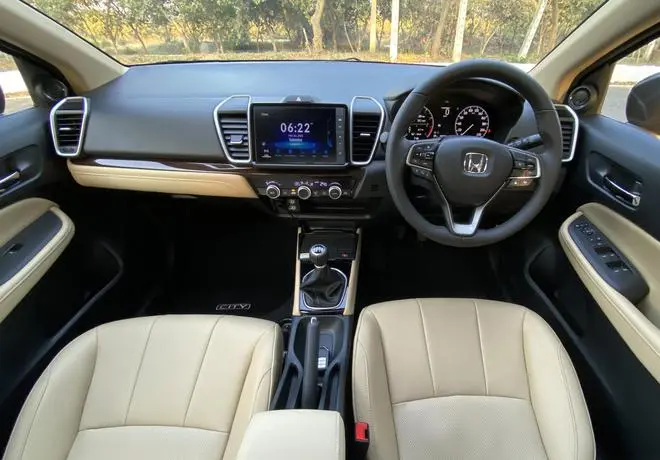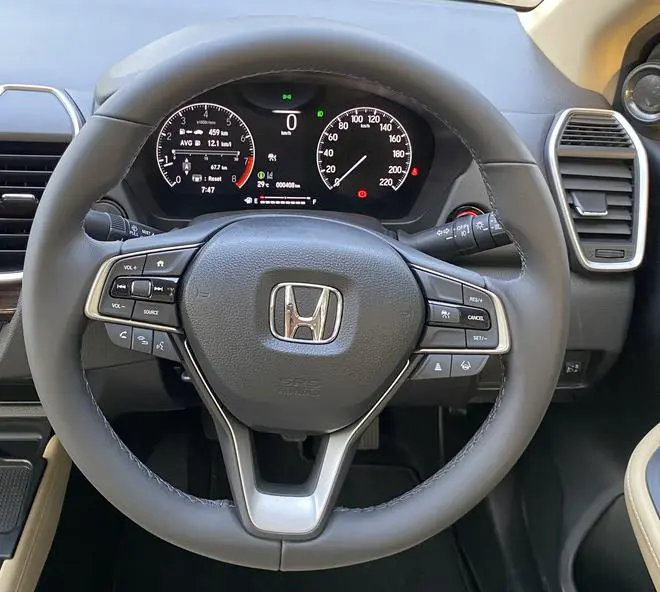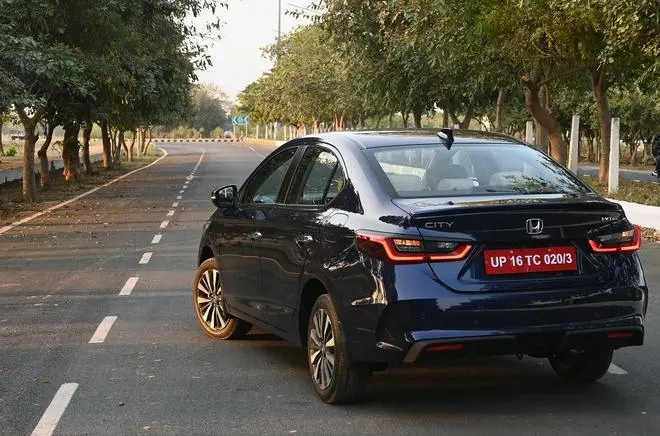The auto industry is hurrying to be ready for the new regulations that are coming up. The new RDE (real-world driving emissions) norms and the need for their powertrains to be E20 compliant (Ethanol 20) would require performance to be tweaked to handle the new fuel composition when it gets rolled out nationwide.
For Honda Car India, which is extremely dependent on the performance of the City sedan, this is not the only reason for the urgency. The City’s biggest competitor, the Hyundai Verna, is due out in a few weeks in its latest avatar. And Honda needs to refresh the City and readjust and rejig the variant mix to keep its appeal at the top. Also, some of the new regulations and changes in market preferences have led to further changes in the lineup. The i-DTEC diesel engine is gone from the City, with very few takers and no real future in sight for diesel. Honda’s India portfolio suffered for want of diesel engines at one point in time, and now it must give them up because regulatory issues have driven the fuel out of buyer preferences. Honda Car India has also rationalised the mix and will now only sell the new facelifted model in both petrol and hybrid powertrain versions.
So, even as Hyundai’s marketing and PR machinery was busy ‘teasing’ the upcoming Verna in my inbox, I travelled to Delhi to test drive the new 2023 Honda City.
Fresh face

The front fender has been redesigned with larger scooped-out sections for the fog lamp housings and a sleeker air dam, and pointy lip sections that have been wrapped in faux carbon-fibre | Photo Credit: Bijoy Ghosh
Last year, Honda introduced the City eHEV, the self-charging strong hybrid of the model. This new version brought hybrid tech to this segment for the first time and introduced some very useful ADAS (advanced driver assistance systems) features to a car in this compact sedan segment. Earlier this month, the company introduced a facelifted City, along with a more affordable, lower trim variant of the eHEV, and made ADAS available to buyers of the top trim petrol variants, all in an attempt to offer customers more choice. This facelift continues to be on the fifth generation Honda City, introduced in 2020. So, it is more like a mid-cycle nip and tuck aimed at bringing its design up to the times. Yet, some of the changes to the front and rear fenders have led to a minor increase (about three cm) in the overall length. The rest of the dimensions of the 2023 Honda City remain the same as the outgoing model.
The front fascia of the Honda City didn’t need change. It was and continues to evoke a modern, techy sort of imagery that worked well for the City. But it still missed a touch of sportiness that would’ve added an element of youth. That seems to have been the focus for the facelift to the exterior design. The front fender has been redesigned with larger scooped-out sections for the fog lamp housings and a sleeker air dam, and pointy lip sections that have been wrapped in faux carbon-fibre. There is more of the stuff in the sporty rear fender diffuser, which is much more aggressive in the way it has been designed with prominent fins that look like they are meant to improve airflow for a performance car. The rest of the rear fender has also been redesigned. My test mule’s boot lip spoiler was the other obvious addition to the petrol versions.

The new dual-tone, machine-cut alloy wheels in two slightly different patterns for the top-trim 16-inches and the lower-trim 15-inches | Photo Credit: Bijoy Ghosh
The headlamp and tail-lamp units with their cuboid, crystal-like sections and the LED DRL and turn indicator elements were already classy and remain largely unchanged. The side profile too remains unchanged except for the new dual-tone, machine-cut alloy wheels in two slightly different patterns for the top-trim 16-inches and the lower-trim 15-inches. The one other new feature for the 2023 City is the new Obsidian Blue Pearl colour that you see in these pictures.
Cabin

The top-trim eHEV variant now gets a faux carbon-fibre finished IP on the dashboard, with piano-black inserts for complementing the pane | Photo Credit: BIJOY GHOSH
The 2023 Honda City also gets a minor refresh to the interior. The changes are largely focused on making the vehicle more usable with hardware changes aimed at executing the new ADAS functions. The top-trim eHEV variant now gets a faux carbon-fibre finished IP on the dashboard, with piano-black inserts for complementing the panel. The earlier model had wood trim. The 7-inch digital instrument cluster is also of higher resolution now, and depending on whether it is on the top-trim eHEV or the petrol powertrain variants, it also displays info regarding power flow, ADAS safety support warnings, and other drive-related information. On the other hand, the 8-inch infotainment system also gets a higher resolution IPS display and is now paired with a higher resolution reversing camera.

The digital instrument cluster is also of a higher resolution now | Photo Credit: BIJOY GHOSH
The impact is visible right away when I get into the cabin of my test mule. The display colours and the image of the rear produced by the reversing camera are both excellent. My only quibble with the display is that it continues to be focused on symmetry and points toward the dead centre instead of having a driver-focused tilt. As a result, the glare during mid-afternoon makes viewing the screen a little difficult. It gets wireless Apple CarPlay and Android Auto connectivity, and remote functions using the iAuto smartphone app via Bluetooth pairing. What the new petrol top trims also get is a sort of “Jugaad” wireless smartphone charger. A simple charging tray unit that takes the shape of and sits firmly in the twin cup holders in front of the gearstick console. Fashioned out of plastic and silicone, the tray needs to be slotted in, and a wire leading out must be plugged into the USB socket right above for the charging to begin. It is effective and nifty considering how I could simply remove it and stash it away in the glove box when not in use. The wire sticking out is the only slightly unsightly bit. But given the fact that cupholders may be used more often than Qi-enabled wireless charging, this might be the way to go. The rest of the cabin is identical to the outgoing model. The seats are extremely well constructed, are comfortable and offer good support for all occupants. The legroom, headroom, and boot volume are all highlights for the Honda City, and these continue to be good. The facelifted model also gets other small feature upgrades, including rain-sensing wipers, a PM2.5 cabin air filter, and ambient lighting on the door panels. There are a few features that competing models offer that are missing in the City.
Powertrain

The new City gets wireless Apple CarPlay and Android Auto connectivity, and remote functions using the iAuto smartphone app via Bluetooth pairing | Photo Credit: BIJOY GHOSH
The petrol-only Honda City continues to be powered by the 1,498 cc, 4-cylinder i-VTEC engine that puts out 121 PS of peak power and 145 Nm of torque. This engine gets the same 6-speed manual transmission and CVT (continuously variable transmission) gearbox as before. This is a free-revving, refined petrol engine that sounds so good to listen to from inside the cabin, though the measured way it puts power onto the wheels may not be at the kind of progress you may be expecting. There is a lot of focus on efficiency, and the rated mileage numbers of about 18 kmpl are indicators for both manual and CVT powertrains. I drove both the manual and the CVT variants and both are excellent transmissions, with smooth, light-clutch shifts in the manual and imperceptible shifts in the CVT without any of the rubber-band effect associated with this type of automatic.
Of course, if you are looking for even more efficiency and a lower carbon footprint for your car, the City variant to buy is the eHEV, which continues to feature the same 1.5-litre Atkinson-cycle petrol engine and battery-electric hybrid. This self-charging, strong hybrid system involves a dual motor and lithium-ion battery pack (sub-1 kW) that act as a series and/or parallel hybrid along with the petrol engine. The total system output is 126 PS and the peak torque is 253 Nm. Regenerative braking ensures that the battery gets recharged during deceleration and braking. Though not defined with a specific range, the eHEV is capable of a pure-electric battery-driven range, and that contributes to a substantial amount of fuel savings.

The boot lip spoiler was the other obvious addition to the petrol versions | Photo Credit: BIJOY GHOSH
ADAS
We reviewed the driver assistance functions (ADAS) in the eHEV. The Honda Sensing system uses feedback from a high-mounted camera to deliver some autonomous features like lane-keeping assist and lane departure warning. The most useful features could well be the not-so-intrusive emergency braking, what Honda calls collision mitigation braking, and the auto high beam. Adaptive cruise control could also come in handy, though the driver needs to be equally alert. In terms of ride quality, the Honda City always scored points for its steady, calm ride quality. There is no change there, and even over bad roads, the City holds its poise. The only points that stick out are the bit of body roll under hard cornering and the higher-than-expected road noise inside the cabin.
Prices
The City is being offered in four grades: SV, V, VX, and ZX for the petrol, and the eHEV hybrid version gets a new V grade, while the ZX trim will continue. Prices for the new facelifted 2023 Honda City range from ₹11.49 lakh for the SV i-VTEC manual to ₹20.39 lakh for the eHEV e-CVT.






Comments
Comments have to be in English, and in full sentences. They cannot be abusive or personal. Please abide by our community guidelines for posting your comments.
We have migrated to a new commenting platform. If you are already a registered user of TheHindu Businessline and logged in, you may continue to engage with our articles. If you do not have an account please register and login to post comments. Users can access their older comments by logging into their accounts on Vuukle.